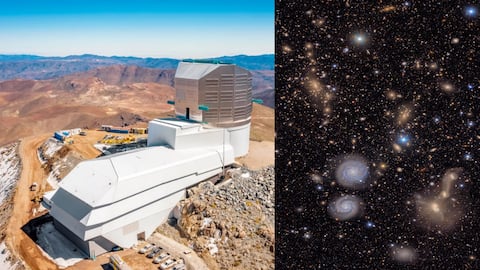World's largest camera captures stunning images of millions of galaxies
What's the story
The Vera C. Rubin Observatory, a revolutionary facility funded by the National Science Foundation (NSF) and the Department of Energy's Office of Science, has released its first images. Located in northern Chile, the observatory is equipped with the world's largest camera (with 3,200MP) and has captured light from millions of faraway stars and galaxies like never before. More images and videos taken using this advanced technology will be released today at 11:30am ET (9:00pm IST) on NSF's YouTube channel.
Mission overview
Asteroids and galaxies captured in 1st images
The first images released by the observatory are just over 10 hours of test observations. They offer a glimpse into the facility's decade-long mission to unravel the universe's secrets. "NSF-DOE Rubin Observatory will capture more information about our universe than all optical telescopes throughout history combined," said Brian Stone, NSF Chief of Staff. The observatory has already discovered 2,104 asteroids, including seven near-Earth ones previously unknown in our solar system.
Advanced technology
Millions of asteroids to be discovered in 2 years
The observatory is expected to find millions of asteroids in its first two years, far surpassing the 20,000 typically found by ground and space-based telescopes annually. Its unique mirror design, sensitive camera, and speed will help it detect faint objects like asteroids. The facility will also take thousands of images every night to track brightness changes and uncover hidden space rocks such as potentially hazardous near-Earth asteroids.
Observation strategy
Telescope's wide field of view
The first images highlight the telescope's wide field of view, which enables detailed views of interacting galaxies and broad views of millions of galaxies. The observatory team also released a mosaic image of the Trifid and Lagoon nebulae, revealing faint details such as clouds of gas and dust. These are star-forming regions located several thousand light-years away from Earth in the Sagittarius constellation.
Placement
Location and scientific observations
The observatory is located in the Andes on top of Cerro Pachon in Chile. It will make its first scientific observations of the Southern Hemisphere's sky using its 8.4-meter Simonyi Survey Telescope on July 4. The telescope's Southern Hemisphere location offers a great view of the Milky Way's galactic center and other celestial phenomena, making it an ideal site for astronomical observations.
Cosmic exploration
Observations will help explore cosmic mysteries
The observatory is expected to help detect new classes of celestial objects and identify interesting areas for other telescopes. "Through this remarkable scientific facility, we will explore many cosmic mysteries, including the dark matter and dark energy that permeate the universe," Stone said. Dark matter is an invisible substance that shapes the cosmos, while dark energy is a force accelerating its expansion rate, according to NASA.
